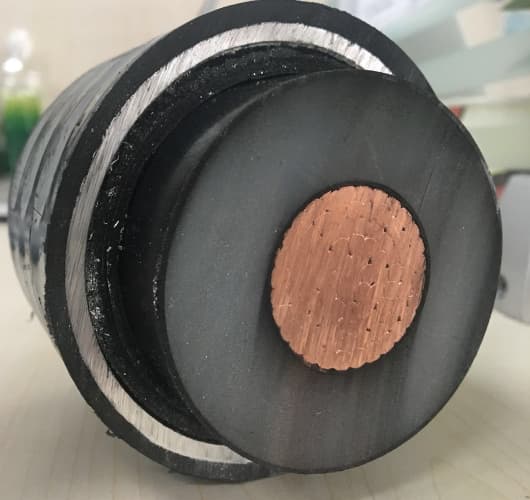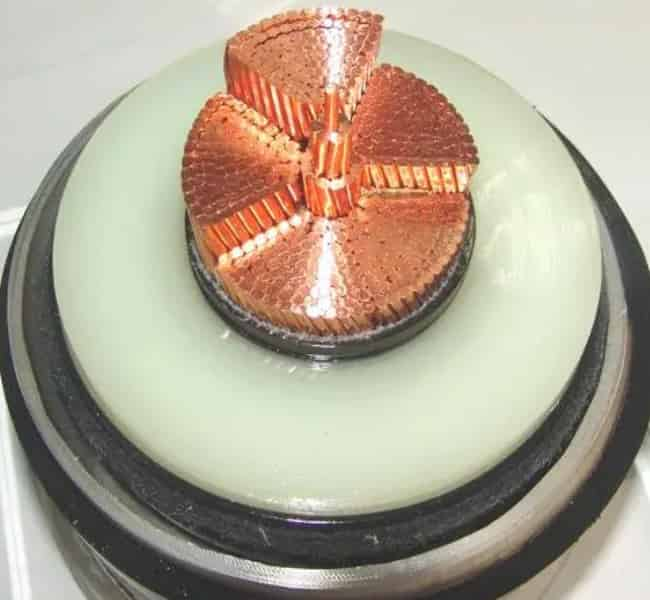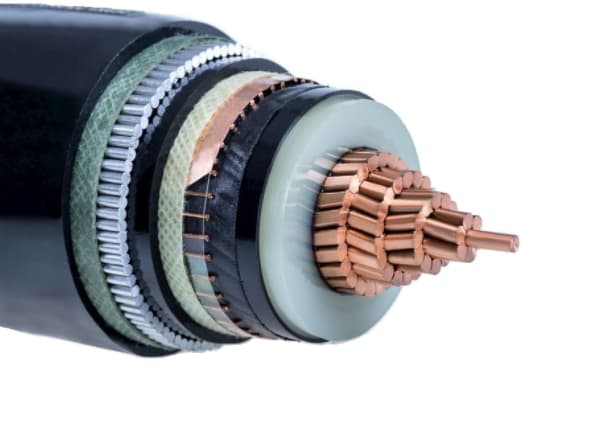In the vast field of power transmission, 230kV Cable, as an important part of very high voltage cables, They are responsible for transporting enormous amounts of energy safely and efficiently to millions of homes. This document will delve into the specifications, characteristics, Applications and key role of XLPE cables (cross-linked polyethylene) 230kV in high voltage transmission systems, while covering common specifications of high voltage cables, The importance of 230kV transmission lines and the unique advantages of underground cables.

I. XLPE Cable Specifications 230 kV Cable: explanation of technical details
XLPE cables 230 kV occupy an important position in the field of high voltage power transmission due to their excellent insulating properties and mechanical strength. These cables mainly consist of a conductor, XLPE insulation, a semiconductor screen, a metal cover (usually corrugated aluminum) and an outer cover (PE a PVC).
Conductor: High purity copper is normally used to ensure good electrical conductivity. Conductor cross section is designed based on current transmission requirements; for cables 230 kV, The common cross section of the conductor is, For example, of 1200 mm², to ensure the stability and efficiency of current transmission.
XLPE insulation: Cross-linked polyethylene insulation is the core part of the cable, which is processed by cross-linking process to form a three-dimensional mesh structure of polyethylene molecular chains, which significantly improves the insulating properties, heat resistance and mechanical resistance. This material has excellent electrical insulation properties and long-term stability, suitable for high voltage power transmission environments.
Semiconductor shielding: Located inside and outside the insulating layer on both sides, It is used to equalize the distribution of the electric field, avoid the phenomenon of partial discharge and protect the insulating layer from possible damage.
Metal cover: usually made of corrugated aluminum, not only does it have good mechanical protection, but can also effectively shield external electromagnetic interference, to ensure the purity of the cable transmission signal.
External cover: 230kV Cable the outer sheath is usually polyethylene (PE) polyvinyl chloride (PVC), providing additional mechanical protection and corrosion resistance, and at the same time adapts to various laying environments.

2. 230kV Cable specifications and performance parameters
Nominal voltage: 230kV Cable Rated voltage of XLPE cable, but in the actual system design, taking into account system voltage fluctuation and insulation margin, the insulation level is usually slightly higher than the nominal voltage, like 245kV.
Frequency: The standard frequency is 50 Hz, adapting to most global power grid systems.
Insulation and tension resistance: Cables undergo strict insulation resistance testing, high voltage resistance tests (such as frequency voltage resistance test, lightning strike tensile strength test), etc., to ensure safe and reliable operation in various extreme working conditions.
In second place, specifications of high voltage cables: the general standard of high voltage cables.
The specifications of high voltage cables must follow a series of international and national standards to ensure that the performance and quality of the cable meet the operating requirements of the electrical system.. These standards cover the structural design of the cable, the selection of materials, the manufacturing process, verification of evidence and other aspects.
IEC Standards: like IEC standards 60228 about drivers, IEC 60502 on power cables, etc., for design, manufacturing and testing of high voltage cables to provide a complete guide 230kV Cable
GB standards: China's national standards on high voltage cable specifications, performance parameters and other detailed provisions, like GB/T 12706 «nominal voltage of 1kV (One = 1.2kV) to 35kV “extruded insulated power cables and accessories” and so on.
Third, the transmission line 230 kV: an important role in high voltage power transmission.
As the backbone of the electrical system, 230kV transmission lines are responsible for transporting energy generated by large power plants to load centers over long distances. These transmission lines are usually overhead or underground., each with its own advantages and disadvantages, But underground cables offer unique advantages in urban energy transmission.
airline: applicable to a wide area, construction costs are relatively low, but is subject to environmental impact, and in the city it is prone to conflict with the urban landscape.
underground cable: although the construction cost is higher, can effectively avoid the impact of bad weather and man-made damage, and at the same time beautify the urban environment and reduce the impact of electromagnetic radiation on surrounding residents. For densely populated urban areas with high land values, underground cables become the preferred option.
Room, very high voltage cables: technological challenges and development trends of very high voltage cables.
With the continuous growth of global energy demand and the accelerated progress of the interconnection of electrical networks, Extra high voltage cable technology faces unprecedented challenges and opportunities. The cable 230 kV, as a representative of one of the extra high voltage cables, Its technological development trend is mainly reflected in the following aspects:
Materials innovation: development of new insulating materials, improvement of the insulation performance and the degree of thermal resistance of the cable, and extension of its useful life.
Intelligence: integration of sensors and monitoring technology to achieve real-time monitoring and early warning of cable working status, improve the security and reliability of the electrical grid.
Environmental protection and energy saving: focuses on the recyclability of cable materials and environmental protection of the production process, to promote the development of green energy transmission technology.
3. 230kV Cable,high tension XLPE: Unique advantages and applications of underground cables
As one of the main types of underground cables, High voltage XLPE cables play an important role in the construction of urban power networks by virtue of their excellent insulation properties and flexible laying methods. Underground cables not only beautify the urban environment, but also effectively reduce electromagnetic radiation and noise pollution.
Improve the quality of life of residents. Besides, AT's XLPE cable has the following unique advantages:
High reliability: HV XLPE cables are insulated with cross-linked polyethylene insulating material, which has excellent electrical performance and mechanical resistance, and can work stably for a long period of time in all kinds of harsh environments, reducing failure rate and maintenance costs.
Flexible laying: Compared to airlines, Underground cables are not limited by terrain and weather conditions, and can be laid flexibly in hidden spaces such as urban underground pipelines, tunnels and bridges, adapting to complex urban environments.
Increase the resistance of the electrical network: underground cables can effectively resist natural disasters (like storms, frost, earthquakes, etc.) and man-made damage (like traffic accidents, construction damage, etc.), to improve power grid resilience and disaster resistance.
Sixth, cases of application of underground cables in the urban electrical network
all over the world, many cities have used or are using underground cables as an important part of urban electrical grid improvements. For example, Paris, London, Tokyo and other international metropolises have widely adopted underground cable systems for efficient electricity transmission., safe and environmentally friendly.
in China, with the acceleration of urbanization and the advancement of the construction of smart networks, The application of underground cables is also increasingly widespread. Beijing, Shanghai, Guangzhou and other first-tier cities are carrying out power grid renovation and new construction projects with a large number of high-voltage XLPE cables, in order to improve the reliability of the electricity supply and the environmental quality of the urban electrical network.
4. 230kV Cable Future Perspectives: technological innovation and sustainable development
Faced with the challenges of the global energy transition and climate change, AT's XLPE cable technology will continue to innovate to meet the development needs of future electrical networks. Future lines of research may include
R&D of new insulating materials: exploration of higher performance insulating materials to improve heat resistance temperature, insulation resistance and cable life.
Intelligence and automation: integration of advanced sensor technologies, IoT and big data to monitor the status of cables in real time, warn of failures and automate maintenance.
Environmental protection and sustainability: focus on the recyclability of cable materials and environmental protection of the production process, develop low carbon and non-polluting cable products, and promote the development of green energy transmission technology.
In conclusion, XLPE cable 230 kV, as an important part of the field of high voltage power transmission, not only carries the great responsibility of energy transmission, but also represents innovation and progress in energy technology. With the continued development of the global power grid and the acceleration of urbanization, High voltage XLPE cables will play a more crucial role in the future power system, providing a secure electricity supply, efficient and environmentally friendly for human society.
5. 230kV Cable Challenges and strategies
Although AT's XLPE cables have many advantages in energy transmission, its development and application continue to face some challenges. Below are some of the main challenges and the corresponding strategies to face them:
1) Cost issues
The initial investment cost of underground cables is usually higher than that of overhead lines, including the cost of materials, the difficulty of construction and subsequent maintenance. To deal with this problem, The following strategies can be adopted:
Design optimization: Reduce material waste and improve laying efficiency by optimizing cable design, thus reducing costs.
Political support and financial subsidies: The government may introduce relevant policies to provide financial subsidies or tax incentives to underground cable projects in order to encourage their construction..
Multi-party cooperation: Promote multi-stakeholder cooperation between electricity companies, governments, promoters, etc., to share construction costs and achieve the sharing of resources and mutual benefits.
2) Construction technology and difficulty
The construction of underground cables involves complex underground engineering, which includes excavation, the laying, connection and many other aspects, with great technical difficulties and risks. For this reason, it is necessary
Improve construction technology: reinforce the technical training of construction personnel, introduce advanced construction equipment and technology and improve construction efficiency and quality.
Strengthen construction management: establish a strong construction management system to ensure the standardization and safety of the construction process.
Scientific planning and design: before cable laying, carry out a geological study and planning design sufficient to avoid uncertainties and risks in the construction process.
3) Operation and maintenance management
The management of the operation and maintenance of underground cables is relatively complex, since it requires periodic tests, maintenance and fault detection. To ensure long-term stable operation of the cable, it is necessary:
Establish an intelligent monitoring system: using advanced technologies such as IoT and big data, Establish intelligent cable monitoring system to achieve real-time monitoring and early warning of cable status.
Formulate operation and maintenance specifications: formulate detailed operation and maintenance management specifications and operating procedures to ensure the standardization and normalization of operation and maintenance work.
Strengthen talent training: form professional operation and maintenance teams, improve the professional skills and comprehensive quality of operation and maintenance personnel, and ensure the quality and efficiency of operation and maintenance work.
4) Environmental protection and sustainable development
With global emphasis on environmental protection and sustainable development, The environmental performance of AT's XLPE cables has also become a focus of attention. To achieve green energy transmission, it is necessary:
Develop environmentally friendly materials: develop low-carbon and non-polluting cable materials to reduce environmental pollution during production and use.
Promote energy saving technology: Incorporate energy saving concepts into cable design and operation, reduce power loss and improve energy efficiency.
Promote the circular economy: reinforce the recovery and reuse of cable waste to promote the development of the circular economy.
6. 230kV Cable Conclusion
In summary, XLPE 230 kV Cable, as an important member of high voltage transmission field, your specifications, performance and application are of great importance to the stable operation of energy systems and urban development. Facing cost challenges, construction, exploitation and protection of the environment, We need to continuously improve the technical level and application effect of cables through technological innovation, political orientation, scientific planning and management optimization. In the future, with the continuous progress of electric power technology and the deepening of power grid construction, AT's XLPE cables will play a wider and more important role worldwide, providing a safer electricity supply, more efficient and more environmentally friendly for human society.

